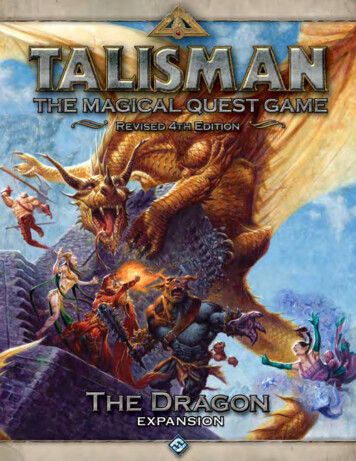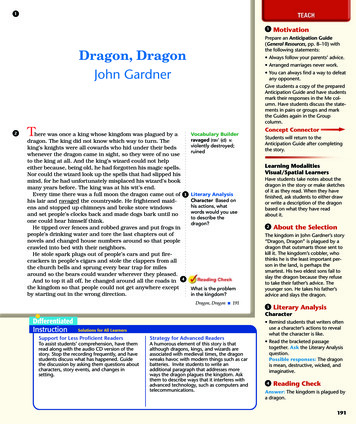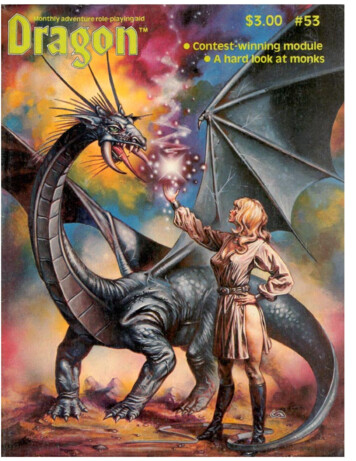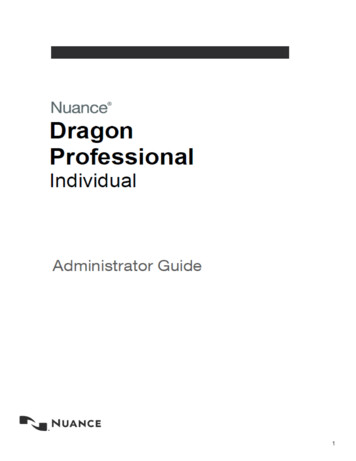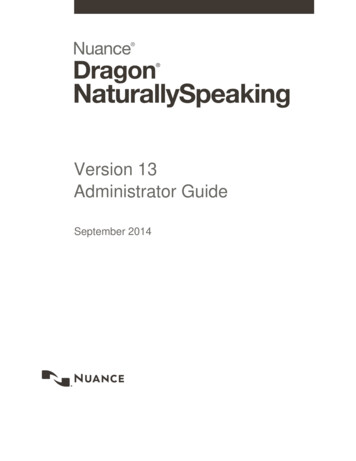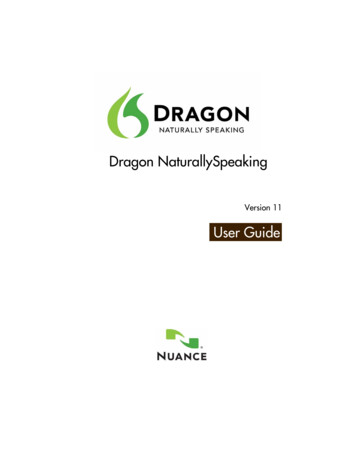
Transcription
February 19821
Vol. VI, No. 8Vol. VI, No. 8In the September 1981 issue (#53) ofDRAGON magazine, I editorializedagainst “assassin” and “killer” games,expressing my fears for potential tragedyto players and potential damage to theimage of the hobby of role-playing gaming. Unfortunately, those fears are beingrealized.On the evening of December 5, 1981, astudent at California State University atLong Beach was shot by campus policeduring a game of “Assassin.” Accordingto the Los Angeles Times Service andUnited Press International, Mike Reaganand a companion, Julia Gissel, both 19years old, were seen by campus policegetting out of a car, carrying what appeared to be rifles. (In actuality, the “rifles” were simulated M-16s that usedrubber-band ammunition.)Sgt. Stephan King of the university police observed the couple moving along awalkway rattling doors, and shouted,“Freeze, police!” The woman stopped,but Reagan turned around, assumed asquatting position and pointed the toygun at King. The sergeant fired his realgun three times, wounding Reagan inthe chest and leg. Reagan was admittedto the intensive care unit of a LongBeach hospital and listed in guardedcondition, but was released from intensive care and listed in in stable conditionas of December 9. University officialssaid King apparently believed the couplewere burglars. There had recently beenmore than a dozen break-ins in the areawhere the shooting occurred.In retrospect, yes, the policeman waswrong, the couple were not a pair of burglars, and their guns were not real. Butwhat would you have had the policemando? Wait to see if he gets hit by a burst ofslugs or just a rubber band? I’m sureproponents of “Assassin” or “Killer” orany of the other so-called “live” roleplaying games (and I still disagree withthat term: “live” role-playing as opposedto what, dead role-playing?), would saythat the area should have been declaredoff limits to the players because of thehigh crime rate, or that Reagan shouldnot have acted as if he were going to firewhen ordered to freeze. And they’d beright. But might not Reagan have assumed that the order to freeze was coming from his “assassin”? Can one foreseeevery possible circumstance in advanceand write every contingency into therules of the game?My point is, simulation of acts of violence will inevitably be interpreted as thereal thing by those not aware that theaction is only simulation. That’s whysomeone holding up a bank with a plastic replica of a pistol may be chargedwith armed robbery, even though no realweapon was used in the crime. It is theperception of the simulation that matters.Beyond the potential for tragedy (I willnot even go into the reports I’ve receivedof idiotic antics like climbing out thirdfloor windows on ropes made of bedsheets to avoid “assassination” — stupidity is stupidity, no matter what thecontext), there is the problem of how thenon-gaming public perceives this type ofgame and those who play it. At St. Ambrose College in Davenport, Iowa, anassassin-type game (they call it “Godfather”) has been organized. A St. Ambrose professor, John Greenwood, hassponsored a resolution circulated amongfaculty members that criticizes the game,and a Davenport newspaper reported,“.he (Greenwood) thinks it (Godfather)can easily get out of hand — much likethe ‘Dungeons and Dragons’ game.” It’sbad enough that Mr. Greenwood apparently has a misconception about theD&D game in the first place, but now itis being reinforced in a negative mannerwith the “Godfather” game, and furtherhe is being quoted by the media asequating the two.Now, the only result of a D&D game“getting out of hand” I can think of isoversleeping the next morning from playing late into the night. And certainly noone is going to mistake a group of peoplesitting at a card table rolling dice andtalking for doing anything more thanplaying a game. But since both “conventional” games (those played with paper,pencil, dice and imagination) and these.these.these things involving players running around with rubber-band guns areviewed the same by people with goodintentions but not all the facts, I’m afraidsome day you’ll hear, “Fantasy roleplaying? Oh, yeah, some kid in California was playing that and got shot, didn’the? They don’t allow that dragons anddungeons stuff at my son’s school.”February 1982Publisher . . . . . . . . . . . . . . . Jake JaquetEditor-in-Chief . . . . . . . . . . . Kim MohanEditorial staff . . . . . . . . . . . Bryce KnorrMarilyn MaysGali SanchezSales . . . . . . . . . . . . . . Debbie ChiusanoCirculation . . . . . . . Corey KoebernickOffice staff . . . . . . . . . . . . . Cherie KnullRoger RauppContributing editors . . . . Roger MooreEd GreenwoodThis issue’s contributing artists:Donna BarrClyde CaldwellHarry QuinnLarry ElmorePhil FoglioDavid LarsonDavid TrampierRoger RauppJames HollowayDRAGON magazine is published monthly byDragon Publishing, a division of TSR Hobbies,Inc. Subscription orders and change-of-addressnotices should be sent to Dragon Publishing,P.O. Box 110, Lake Geneva WI 53147. Telephone (414) 248-8044.DRAGON magazine is available at hundredsof hobby stores and bookstores throughout theUnited States and Canada, and through a limited number of overseas outlets. Subscriptionrates are as follows, with all payments to bemade in advance: 24 for 12 issues sent to a U.S.or Canadian address; 50 U.S. for 12 issues sentvia surface mail or 95 for 12 issues sent via airmail to any other country.A limited quantity of certain back issues ofDRAGON magazine can be purchased directlyfrom the publisher by sending the cover priceplus 1.50 postage and handling for each issueordered. Payment in advance by check or money order must accompany all orders. Paymentscannot be made through a credit card, andorders cannot be taken nor merchandise “reserved” by telephone. Neither an individual customer nor an institution can be billed for a subscription order or back-issue purchase unlessprior arrangements are made.The issue of expiration for each subscriptionis printed on the mailing label for each subscriber’s copy of the magazine. Changes of address for the delivery of subscriptions must bereceived at least 30 days prior to the effectivedate of the change in order to insure uninterrupted delivery.All material published in DRAGON magazinebecomes the exclusive property of the publisherupon publication, unless special arrangementsto the contrary are made prior to publication.DRAGON magazine welcomes unsolicited submissions of written material and artwork; however, no responsibility for such submissions canbe assumed by the publisher in any event. Anysubmission which is accompanied by a selfaddressed, stamped envelope of sufficient sizewill be returned to the contributor if it cannot bepublished.DRAGON is a trademark for Dragon Publishing’s monthly adventure playing aid. All rightson the contents of this publication are reserved,and nothing may be reproduced from it in wholeor in part without prior permission in writingfrom the publisher. Copyright 1982 by TSRHobbies, Inc. USPS 318-790. ISSN 0279-6848.Second class postage paid at Lake Geneva,Wis., and at additional mailing offices.2
February 1982laying an AD&D adventure is, as we so often say,an exercise in imagination. But all the imaginationin the world isn’t going to help when you (or worseyet, the DM) can’t remember which spells you’vecast and which ones you have left. What is going tohelp is SPELLMINDERS, our latest AD&D playing aid, whichyou’ll find in the center of this magazine.The idea for SPELLMINDERS came from Bill Fawcett, one ofour regular contributors, and his associate Lance Davenport.They compiled the information which appears on the countersand made the sometimes difficult decisions about which spellsshould be represented more than once. Only magic-user andcleric spells are included in this original set, but if we getenough positive feedback from you, we’ll print up illusionistand druid spells in the same form sometime soon. Let us knowwhat you think of the idea — either way.And we might even throw in the new, official cleric spells fromthe latest edition of Leomund’s Tiny Hut. Yep, I said official. Ouresteemed columnist, Len Lakofka, thought that clerics deserved more spell abilities than provided for them in the AD&Drules. So he wrote up some new spells and sent them to GaryGygax for his evaluation and approval — and Gary sent them tous, along with his permission to portray them as new rules.This month’s cover, “Escape from Skull Keep,” was paintedespecially for DRAGON Magazine by Clyde Caldwell, whosefirst appearance as a cover artist was on the front of issue #53.At that time, I didn’t see how he could do any better — but nowthat I’ve seen Clyde Caldwell painting number two, I can’t waitfor number three.Dwarves may be, ahem, a short subject. But we’ve gone togreat lengths inside, starting on page 23, to give the little guystheir due. Contributing editor Roger Moore supplied most ofthe material for a special section on dwarves and the deitiesthey worship. This is the first set of articles in a series of studieson non-human races which will appear over the next severalissues. We’ll get to your favorite sooner or later.Mythical monsters and fictional figures from ancient Greeceoccupy a big part of our feature section. “The Blood of Medusa”is Michael Parkinson’s description of the legendary creaturesand characters spawned by the lady with the strange hairdo.Following that piece are four portrayals of NPCs from the sameera, but certainly not the same family tree.Surrounding the SPELLMINDERS section in the center of themagazine is “In the Bag,” another tale of the tribulations ofBoinger and Zereth from the pen of J. Eric Holmes, who is botha well-known fiction writer (check out your local bookstore)and the author of a new book on fantasy role-playing (ditto).Next in line is a trio of treatises on archery. Robert Barrowoffers some facts and figures based on real experience, concerning how far an archer can shoot and how easily he can hitwhat he’s aiming at. Carl Parlagreco presents a short system for“Making bowmanship more meaningful,” and the third article inthis section proposes a way to differentiate between bows ofdifferent strengths and the varying amounts of damage theirarrows can cause. But if hand-held weapons are more yourcharacter’s style, forge ahead into David Nalle’s essay on thedesign and development of the sword.“Being a bad knight” is the first article we’ve ever publishedon the KNIGHTS OF CAMELOT game, and it comes straightfrom the source — Glenn Rahman, the author of the game’soriginal rules. And, for Traveller fans, there’s “Anything buthuman,” Jon Mattson’s system for creating alien characters.Topping off issue #58 is a special two-page “What’s New,”Phil Foglio’s whimsical tribute to Valentine’s Day, and a onepage “Wormy” which is, as usual, a tribute to the talent andimagination of Tramp. — KMSPECIAL ATTRACTIONSPELLMINDERS — Counters for keeping magic-userand cleric spells straight . . . . . . . . . . . . . . . . . . . . . . . . . . . . 39Being a bad knight — KNIGHTS OF CAMELOT variant. . 61Anything but human — Making aliens in Traveller . . . . . . . . 65OTHER FEATURESThe Blood of Medusa — Family tree of monsters . . . . . . . . .Four myths from Greece — A sharp shooter, a high flyer,a know-it-all, and a centaur . . . . . . . . . . . . . . . . . . . . . . . . .Dwarves: A special section . . . . . . . . . . . . . . . . . . . . . . . . . . . . . .The dwarven point of view . . . . . . . . . . . . . . . . . . . . . . . . . . . .Bazaar of the Bizarre — Magic items for dwarves . . . . . . .Sage Advice — Questions and answers . . . . . . . . . . . . . . . .The gods of the dwarves . . . . . . . . . . . . . . . . . . . . . . . . . . . . . .In the Bag — Fiction by J. Eric Holmes . . . . . . . . . . . . . . . . . .Aiming for realism in archery . . . . . . . . . . . . . . . . . . . . . . . . . . .Bowmanship made more meaningful . . . . . . . . . . . . . . . . . . . .A long bow isn’t always a strong bow . . . . . . . . . . . . . . . . . . . .Swords: Slicing into a sharp topic . . . . . . . . . . . . . . . . . . . . . . .REGULAR OFFERINGSOut on a Limb — Letters from readers . . . . . . . . . . . . . . . . . . . . 4Leomund’s Tiny Hut — New spells for clerics . . . . . . . . . . . . . 5Dragon’s Bestiary:Sull . . . . . . . . . . . . . . . . . . . . . . . . . . . . . . . . . . . . . . . . . . . . . . . . . . 8Beguiler . . . . . . . . . . . . . . . . . . . . . . . . . . . . . . . . . . . . . . . . . . . . . . 9Magenta’s Cat . . . . . . . . . . . . . . . . . . . . . . . . . . . . . . . . . . . . . . . 10Dragon’s Augury:Griffin Mountain . . . . . . . . . . . . . . . . . . . . . . . . . . . . . . . . . . . . . 68Star Patrol . . . . . . . . . . . . . . . . . . . . . . . . . . . . . . . . . . . . . . . . . . . 68Trillion Credit Squadron . . . . . . . . . . . . . . . . . . . . . . . . . . . . . . 69Paranoia Press products . . . . . . . . . . . . . . . . . . . . . . . . . . . . . . 69Off the Shelf — Book reviews . . . . . . . . . . . . . . . . . . . . . . . . . . . 71What’s New . . . . . . . . . . . . . . . . . . . . . . . . . . . . . . . . . . . . . . . . . . . . 78Wormy . . . . . . . . . . . . . . . . . . . . . . . . . . . . . . . . . . . . . . . . . . . . . . . . 801118232427283136475050553
Vol. VI, No. 8‘Doubly pleasing’Dear Editor:I just finished reading DRAGON #56 and, assomeone who enjoys both AD&D and TOPSECRET I found this issue doubly pleasing.Congratulations are in order for Merle Rasmussen and James Thompson for MADMERC. It was a welcome sequel to DR. YES(issue #48).While I liked MAD MERC very much andfound almost all the information to be complete and accurate, I did find one not-so-tinyerror that if overlooked by the Administratorcould be fatal. The error is found in the personnel traits and abilities section listing forHurt (medical nurse). Hurt is listed as having aPhysical Strength of 41, a Willpower of 37, yethe has an incredible Life Level of 78! Apparently, Mr. Rasmussen forgot to do the laststep in the L.L. equation, that is, to divide by10, and this would result in the corrected L.L.of 8.I hope all Administrators will correct thiserror before taking Agents through this module, so that no poor Agents will encounterHurt, who would be almost impossible to hurt.Paul H. CordtsOrchard Lake, Mich.Good job, Paul. You spotted a mistake thatescaped the notice of our proofreader. (That’sthe last time we hire a flesh golem to do ahuman’s job.) The mistake wasn’t Merle’sfault — and neither were the other two blunders that also appear in the chart on pages48-49 of issue #56.The problem with Hurt’s statistics begins’way back in the Courage column. Merle’smanuscript listed figures of 37 for Hurt’s Willpower and Courage. When the chart was setinto type, that number was typed once insteadof twice, and everything else got pushed oneplace to the left as a result. The identical problem occurred in the listing for Smith (mechanical engineer). That character was supposedto have Courage of 75 as well as Willpower of75. The third mistake is in the listing for Lange(carpenter), whose languages got garbled.The corrected listings for Hurt should read:Courage 37, Knowledge 102, Coordination85, Offense 61, Deception 55, Evasion 79,Hand-to-Hand 120, Surprise 134, Life Level 8,and Language ratings of Japanese 78, English 05, and German 54.For Smith, make the following changes:Courage 75, Knowledge 89, Coordination 81,Offense 78, Deception 85, Evasion 88, Handto-Hand 117, Surprise 163, Life Level 10, Japanese 7, English 79, and German 60.Lange’s language abilities should be English 25 and German 94.That should set the record straight. Ourapologies to anyone else who noticed one ormore of the errors and wasn’t able to figureout what the ratings should have been. — KM‘Too scalding’Dear Editor:I think “Out on a Limb” is a very good feature to have, and it shows what people reallythink of your magazine. But it seems to methat when a person writes in a criticism youare (just maybe) a little too scalding with youranswer. Take DRAGON #53 and the letter byAdam Rosenblatt about you being too “highhanded.” Take a little time out to read yourreply. See? Whew! You’ll be lucky if he buys aDRAGON magazine, let alone touches one!Perhaps you could be a little more amiablewith your editorial responses.Now, if what I have been trying to tell yousinks in, your response to my letter will be oneof understanding. If not, well then, at least itwill be amusing to others as they read it.Jeff RabkinNew York, N.Y.Dear Jeff:We think “Out on a Limb” is a very goodfeature to have, too. But it seems to us thatwhen people write in a criticism they are (justmaybe) a little too scalding in their accusations. Take a little time out to read some of themail we get. See? Whew! We’ll be lucky if wecan ever again work up the courage to open aletter. Perhaps readers could be a little moreamiable when they call us high-handed.Now, if what I have been trying to tell yousinks in, your reaction to this response will beone of understanding. If not, I hope somebody gets a chuckle out of it. — KMMeyers on monksDear Editor:In DRAGON #53 there are some changes inthe monk class. Special ability “S” says themonk will get a premonition of death 1-4 turnsbefore it happens. How does the DM go aboutdoing this?ConfusedThe following reply was provided by PhilipMeyers, the author of the article in question:The original “premonition of death or serious harm” comes from page 163 of theDMG, Table V, prime power Q under artifactsand relics. There are two problems inherent in4this question: how to play the premonition inthe case of a non-player character monk, andfor a player character. The case of the NPC isthe simpler one. If the party is about to encounter a NPC monk with the premonitionpower, the DM must make a determination ofwhether the party has the power to kill orseriously harm the monk, and if it does,whether the party is likely to attack the monk,or may even possibly attack the monk. If theparty is sufficiently powerful and there is areasonable chance the party will attack, theroll for the premonition should be made. Themonk to whom the premonition occurs will beready and waiting when the party arrives.The case of the PC monk is more difficult,because the DM cannot predict what a playercharacter will do, and thus cannot predictwith certainty whether a dangerous situationwill arise in the future. The power is thereforeonly applicable when it appears to the DMthat the PC monk is headed for a dangerousencounter, and there is a substantial chancethe encounter will occur. The character shouldalways be able to avoid the encounter if circumstances permit, so that the event likely tobring about death or serious harm neverhappens. In any event, the premonition is always simply a vague feeling that great dangeris imminent, not a specific vision of a futureevent. For player character monks the premonition should not occur often, since amonk of such high level is seldom in greatdanger, particularly when the monk is surrounded by similarly powerful companions.‘Different games’Dear Editor:I see my latest DRAGON has another letterobjecting to high-level characters. I thinkyour readers need a lesson in softball!The basic rules for softball are used for twoquite different games, “fast-pitch” and “slowpitch.” The rules are almost all the same inboth games, yet the two games feel very different and call for very different abilities in theplayers. Of course, every player prefers his orher version, but very few would argue that theother isn’t a good game, too, for those whosepreferences are in the other direction.I could also remark on the many differentforms of poker — straight, lowball, wild-card,7-card, you name it. Every poker player hashis or her favorite version, and, for example, a“straight” player may look down on one whoprefers 7-card stud. But poker, all versions, isa great game.To get back to AD&D, the regular game is a(Turn to page 77)
February 1982Beefing upthe clericINTRODUCTIONAll readers should be a ware that LenLakofka has been of considerable aidand assistance in formulating the wholeof the AD&D game system. Obviously,Len’s contributions did not end with thepublication of the four volumes of theinitial release. He writes this column. Lenis instrumental in a revision of the FIENDFOLIO Tome currently under way atTSR. Last but by no means least, he freely contributes suggestions and materialfor work planned to augment the AD&Dsystem.I am working on new monsters, magic,classes, and information for two new volumes of the system — a supplement forplayers and DMs alike, and a secondbook of the Monster Manual — projectedfor release in three to four years. Much ofthe supplementary material has been orwill be printed in various modules or inDRAGON Magazine. For instance, manynew spells are included in the upcomingmodules Lost Caverns of Tsojcanth andTemple of Elemental Evil. (Yes, fans, it isagain being worked on!)When Len and I last spoke he broughtup the paltry choice of spells for clerics,and I concurred that something neededto be done. Now go on and read what hasbeen accomplished, for the spells are“official” and will appear in virtually thesame form in a future volume of theAD&D series.Gary GygaxDice First level spells01-17 Ceremony (Coming of Age)18-35 Ceremony (Burial)36-50 Ceremony (Marriage)51-54 Combine55-65 Endure Cold66-77 Endure Heat78-90 Magic Stone91-96 Magical Vestment97-00 091-9798-00Second level spellsCeremony (Dedication)Ceremony (Investiture)Ceremony (Consecrate Item)Death PrayerDetect LifeHoly SymbolMessengerThird level spells01-20 Ceremony (Ordain)21-40 Ceremony (Special Vows)41-48 Dust DevilAUTHOR’S INTRODUCTIONGary Gygax and I have discussed thecleric at some length, and we agreed thatthe spells for that class, especially at thefourth level, needed a little work andperhaps a few additions. Gary asked meto write a few spells that might be included in an edition of the AD&D PlayersHandbook. Following are six first-levelspells, four second-level spells, fourthird-level spells and two fourth-levelspells that I submitted to Mr. Gygax forreview. (Editor’s note: Mr. Gygax mademany minor additions and alterations tothe spell descriptions — and deleted acouple of suggested spells — before declaring the group to be “official” rule additions. All of his changes are incorporated in the descriptions given below.)Comments from readers would also begreatly appreciated.New spells should be placed into thegame with great care. Allow non-playerNEW CLERIC SPELLSThird level spells (cont.)EnthrallRemove ParalysisWater WalkingFourth level spells01-44 Ceremony (Consecrate Ground)45-72 Meld Into Stone73-00 Negative Plane ProtectionFifth level spellsCeremony (Anathematize)SPELL DESCRIPTIONSFirst LevelCeremony (Conjuration/Summoning)Level: 1Range: TouchDuration: PermanentArea of effect: One creature, one item,or area (see below)Components: V, S, MCasting time: 1 hourSaving throw: None or Neg. (see below)5characters to learn of them and thenpass them on to player characters viathat method. Some spells like Ceremony,Endure Heat/Cold (for appropriate regions of the “world”), Holy Symbol, andOrdain are, due to the way they are written, likely to be widely known and mighthave to be given to existing playercharacter clerics without too much nonplayer character interaction.When a non-player cleric is encountered, determine if he/she knows any ofthe new spells given. For each spell levelin question, beginning at first and goingup as high as the NPC’s experience levelwill permit, multiply the experience levelof the non-player cleric by 7% to determine the chance that he/she knows (canpray for) one of the new prayers/spells. Ifthe roll indicates knowledge, roll percentile dice again and consult the lists belowto determine which particular spell/prayer is known.If a second or subsequent roll on thelist below yields a duplicate result, rollagain until an “unknown” spell comesup. Repeat the initial “chance to know”roll until a negative result is obtained oruntil all available new spells of the givenlevel are known.Explanation/Description: Ceremonyhas a number of applications in the cleric’s organization, depending on the levelof the cleric. Each Ceremony is used as aparticular blessing/curse of the organization. The spell is used to put the holy/unholy seal on the event and does notproduce an aura of magic, though insome cases an aura of good or evil mightbe present. The types of Ceremony canvary from organization to organization,but usually encompass these:1st-level cleric: Coming of Age, Burial,Marriage3rd-level cleric: Dedication, Investiture, Consecrate Item5th-level cleric: Ordain, Special Vows7th-level cleric: Consecrate Ground9th-level cleric: AnathematizeEach of these blessings (Anathematize is a curse) requires a cleric of theappropriate level or higher. Briefly, theCeremonies listed do these things:Coming of Age blesses a young man
Vol. VI, No. 8(and in some cultures a young woman)at some point in time, often the age of 12.Coming of Age may or may not allow theperson who has come of age any particular rights.Burial in no way protects the corpse,but gives the blessing of the organization, and is said to have a 50% chance toinvoke retribution of some type if thebody’s grave is dug up within one weekof burial (i.e., an agent of the deity willcome to protect the grave).Marriage is certainly straightforward.Dedication is necessary to performspecific acts, such as becoming a member of an organization.Investiture is required for a pre-clericto become 1st level.Consecrate Item is required for everyitem placed on an altar and at other places in a religious edifice, as required bythe particular organization. Holy symbols and vestments are handled separately (q.v.), but holy/unholy water/oilmust be kept in consecrated containers.Ordain is required for a 2nd-level cleric to become the priest of a small congregation or assume similar duties. Evenhigh-level clerics must at some time beordained before they have the right togain followers and form a following orgroup. This is often a part of training tobecome 3rd level by a cleric of the appropriate belief.Special Vows pertain to paladins,knighthood, and solemn oaths.Consecrate Ground is required whenany holy/unholy structure is built. Achurch, abbey, sanctuary, monastery,temple, etc., built on unconsecratedground has a 1% chance per year (cumulative) to collapse! Once a structure isbuilt, consecration cannot be an afterthought: Thus, a cleric of 7th level orhigher must be sought when a clericalstructure is to be built, or else! Consecrate Ground is also used in graveyards.The graveyard can then turn undead as ifit were a 3rd-level cleric.Anathematize is a strong form of excommunication in which the offender isliterally branded on the cheek, forehead,arm, or hand with a symbol, sigil or signthat denotes an offense to his/her god.An Atonement spell can remove theonus, but the brand will only fade in intensity; it will never disappear. Exception: A cleric who sins in the sight of hisorganization due to adverse magic canfully atone and the anathema is fullyremoved.Material components for Ceremoniesare variable, and the costs of the organization also vary. Some common chargesare as follows: Coming of Age, 5-15 sp;Burial, 5-50 gp; Marriage, 1-20 gp; Dedication, 0-10 sp; Investiture, 0-100 gp;Consecrate Item, usually free; Ordain,6usually free but up to 200 gp; SpecialVows, 0-100 gp; Consecrate Ground,usually 100-600 gp depending on thesize of the site and the rank of the clericdoing the consecration. Anathematizedoes not cost any gold.Combine (Alteration)Level: 1Duration: See belowRange: TouchArea of Effect: Circle of clericsComponents: V, SCasting Time: 1 roundSaving Throw: NoneExplanation/Description: Via this spellfive clerics of the same alignment canadd their powers to perform a specificfunction. The cleric of highest level, orone selected by the group if all are ofequal level, stands in the center of a circle formed by the other four who holdhands and kneel around him/her. Thisprocess takes one full round, and all fiveclerics must be chanting the words to thespell Combine at the same time. If one ofthem stops for any reason, the spell iswasted for all five of them.The cleric in the center can then, onthe round after the casting of the Combine spell, attempt to cast a spell or turnundead as if he/she were higher thanactual level, for the determination ofrange, duration and area of effect as ap-
February 1982plicable. The spell cast (or effect) will beat a combined level for the five clerics, upto 4 additional levels maximum, as explained below.Only the cleric in the center needknow and have prayed for the spell to becast by the combination. Only informational, protection (including Dispel Magic), and curative spells can be combinedin this way. The clerics may also CreateFood & Water or turn undead. The fourclerics comprising the circle are in adeep trance that to recover from will require one full round. During the trance,surprise is automatic and all “to hit” rollsare at 4 against the clerics in hand-tohand combat. Naturally, they cannot useshields or dexterity bonuses in calculation of their armor classes. Thus, if thecombination is physically attacked onlythe center cleric can muster any defenseon the first round. If he selects an attackspell of any type, the cleric reverts tohis/her original level at once and thecombination is broken.The combination can otherwise remaintogether for the casting of one spell orone attempt at turning undead. Then thespell breaks and the four clerics comprising the circle must recover for a fullround before they can do anything else.If a cleric dies the combination is broken,but not if one is only hit for damage onc
DRAGON magazine, I editorialized against "assassin" and "killer" games, expressing my fears for potential tragedy to players and potential damage to the image of the hobby of role-playing gam-ing. Unfortunately, those fears are being realized. On the evening of December 5, 1981, a student at California State University at


